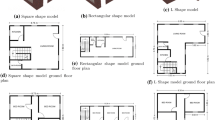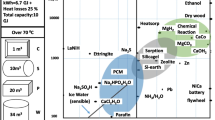Abstract
Presently, buildings are expected to be designed to meet higher energy performance, sustainability to enjoy healthy and comfortable environment for the occupants. With the growing public awareness of environment issues, the energy efficient design concept for construction of buildings is being accepted to reduce the day-to-day energy demand of the buildings. In this scenario, net zero energy building design is one of the solutions to combat global warming by reducing energy demand and simultaneously use of renewable energy to run the operations of the building. In this paper, the focus is given on net zero energy building design criteria for composite climate zone. The technical parameters of planning, orientation, envelope, heating ventilation and air-conditioning (HVAC), use of energy efficient materials and integration of renewable energy system in designing the net zero energy building were analyzed and evaluated. The net zero energy balance equation was established from the building design strategies by evaluating the total annual energy demand, reduction in annual energy consumption implementing energy efficient technologies and annual renewable energy generation under the boundary of the building. This equation of net zero energy building was validated on design and construction of BISA building located at Ludhiana, Punjab falls under the composite climate zone. The analysis, evaluation and validation were carried out on system-generated model of the building. The reduced annual energy demand of the building of 432,742 kWh was met from the renewable energy generation of rooftop solar photovoltaic power plant of capacity 300kWp and satisfied the net zero energy balance equation.








Similar content being viewed by others
References
S. Igor et al., Net zero energy buildings: a consistent definition framework. Int. J. Energy Build. 48, 220–232 (2012)
M. Shubhangi et al., A review study on net zero energy building. Int. Res. J. Eng. Technol. 04(04), 1567–1570 (2017)
D. Kolokotsa et al., A roadmap towards intelligent net zero – and positive energy buildings. Sol. Energy 85(12), 3067–3084 (2011)
H. Ala, Optimal Design of Net Zero Energy Buildings (Linköping University Electronic Press, Swedon, 2011).
Shady G. Attia, Andre De Herde, “Early Design Simulation Tools for Net Zero Energy Building: A comparison of Ten Tools” Proceedings of Building Simulation of Conference of International Building Performance Simulation Association, Sydney, 14–16 November, 2011.
T. Albert et al., A systems simulation framework to realize net-zero building energy retrofits. Sustain. Cities Soc. 41, 405–420 (2018)
H. Fatima et al., Multi-objective optimization methodology for net zero energy buildings. J. Build. Eng. 16, 57–71 (2018)
H. Richard, et. al. (2012) A design framework for achieving net zero energy commercial buildings. 46th Annual International Conference of Architectural Science Association, At Griffith University, Australia, Vol.1
Oh. Jeongyoon et al., Advanced strategies for net-zero energy building: focused on the early phase and usage phase of a building’s life cycle. MDPI J. Sustain. 9, 2272 (2017)
A. Ajla, Regenerative design of existing buildings for net-zero energy use. Elsevier Proc. Eng. 118, 72–80 (2015)
B. Fausto et al., A design strategy to reach nZEB standards integrating energy efficiency measures and passive energy use. Elsevier Energy Proc. 111, 205–214 (2017)
Z Gerhard, et. al. (2012) Building automation for increased energy efficiency in buildings. In: IEEE international symposium on industrial electronics. Hangzhou, pp.1191–1196. https://doi.org/10.1109/ISIE.2012.6237258
S. Attia et al., Overview and future challenges of nearly zero energy building design in Southern Europe. Energy Build. 155, 439–458 (2017)
M.S. Anju, Comparison of cost and energy efficiencies of zero energy residential building and conventional building. IJESI 6(7), 64–71 (2017)
J. Sruthi, P. Gokuldeepan, Design of net zero residential building. Int. J. Adv. Res. Ideas Innov. Technol. 4(3), 1395–1397 (2018)
S.C. Patil et al., Net zero energy building. Int. J. Res. Appl. Sci. Eng. 5, 835–839 (2017)
F. Garde et al., Design of net zero energy buildings: feedback from international projects. Energy Proc. 61, 995–998 (2014)
L. Aelenei, et. al. (2012) Design issues for net zero energy buildings. LNEG Report ZEMCH
C. Becchio et al., Toward NZEB by optimizing HVAC system configuration in different climates. Energy Proc. 140, 115–126 (2017)
A. Natale et al., The role of the thermal mass in nZEB with different energy systems. Energy Proc. 101, 121–128 (2016)
C. Cristina et al., The influence of daylighting in buildings with parameters nZEB: application to the case study for an office in Tuscany Mediterranean area. Energy Proc. 140, 339–350 (2017)
N. Nafici, M.F.M. Zain, The role and function of thermal insulation in architecture. J. Des. Built 4, 63–73 (2011)
K. Theoni et al., The concept of smart and NZEB buildings and the integrated design. Proc. Eng. 180, 1316–1325 (2017)
W. Zeiler, Integral design: the new roles for architect ad engineers for developing nearly zero energy buildings. Int. J. Innov. Sustain. Dev. 9(2), 137–156 (2015)
A. Shady et al., Achieving informed decision-making for net zero energy buildings design using building performance simulation tools. Build. Simul. 6, 3–21 (2013)
V.M. Barthelmes et al., Design and construction of an nZEB in Piedmont region, North Italy. Energy Proc. 78, 1925–1930 (2015)
G. Habash et al., Sustainable design of a nearly zero energy building facilitated by a smart microgrid. J. Renew. Energy 2014, 1–11 (2014)
R.H. Abdellah et al., The potential of net zero energy buildings concept at design state for healthcare buildings towards sustainable development. Conf. Ser. Mater. Sci. Eng. 271, 1–9 (2017)
Author information
Authors and Affiliations
Corresponding author
Additional information
Publisher's Note
Springer Nature remains neutral with regard to jurisdictional claims in published maps and institutional affiliations.
Rights and permissions
About this article
Cite this article
Singh, B., Sharma, S.K. & Syal, P. Net Zero Energy Building (NZEB) Design. J. Inst. Eng. India Ser. A 102, 237–247 (2021). https://doi.org/10.1007/s40030-020-00500-1
Received:
Accepted:
Published:
Issue Date:
DOI: https://doi.org/10.1007/s40030-020-00500-1




